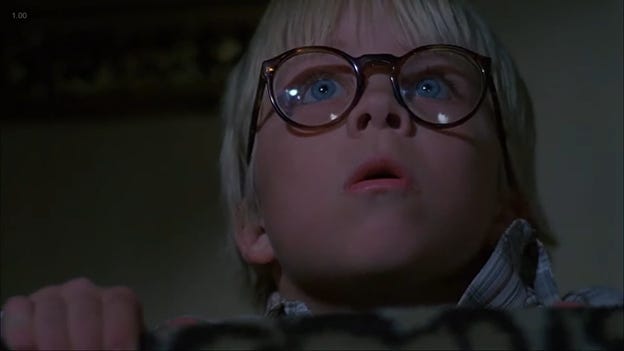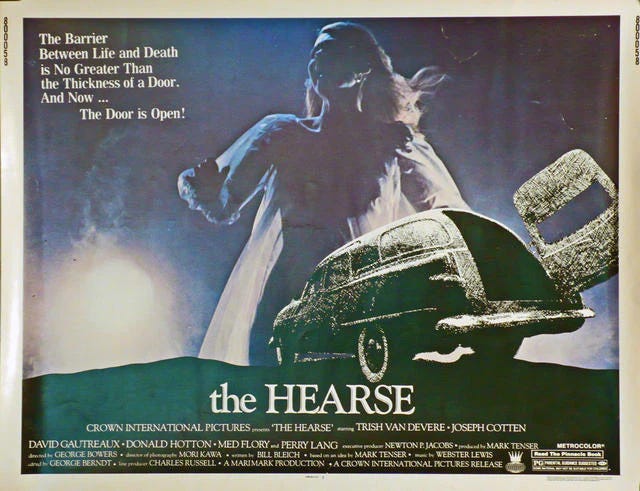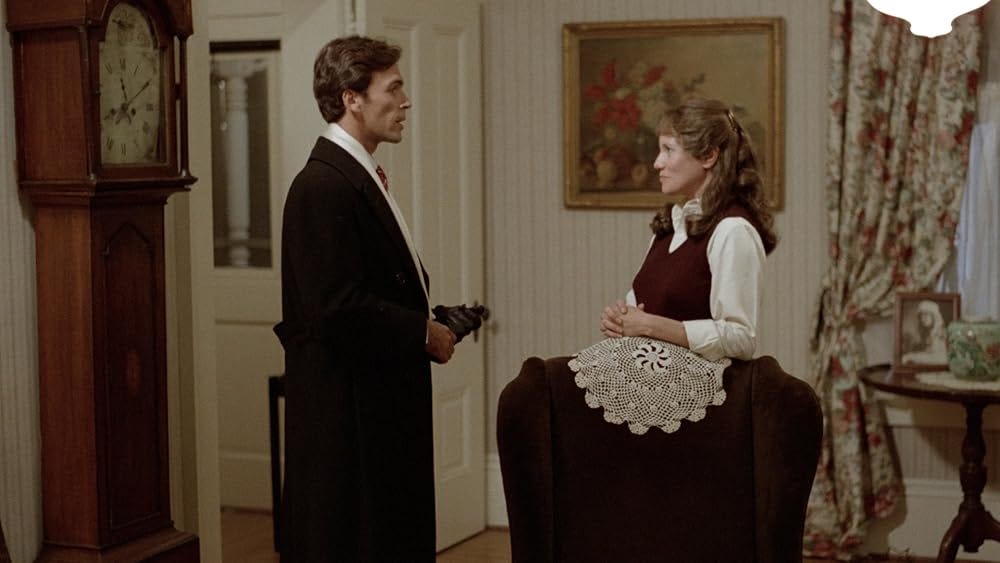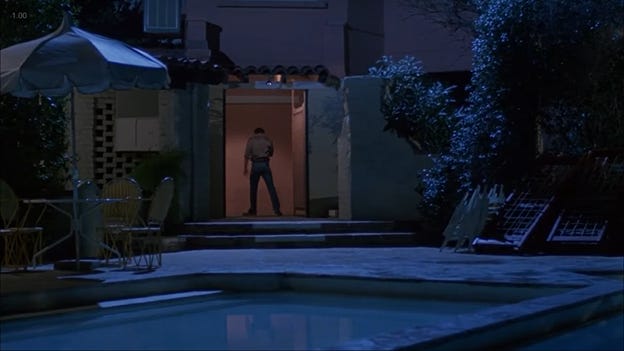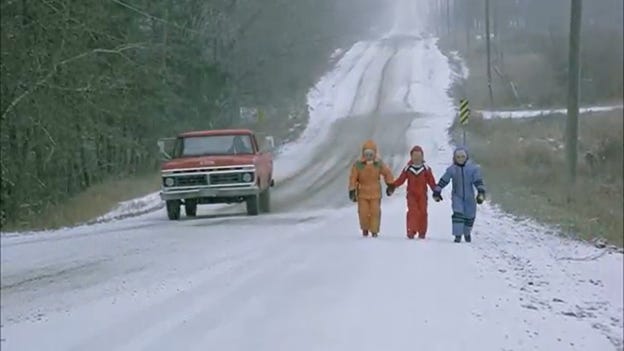The new era of divorce movies that begins in the late 1970s and early 1980s includes several pairings of divorce and horror. This may not be surprising to anyone who has tried dating again after divorce, or who has gone through a rancorous custody battle. But in film history terms, divorce horror can be seen as another new alternative to earlier plot and genre frameworks, part of what I call the Age of Deuterogamy.
This handful of films takes aspects of the new divorce movie—post-marital dating (e.g., An Unmarried Woman), the next marriage-bound relationship (e.g., The Goodbye Girl), and custody conflict (e.g., Kramer vs. Kramer)—and turns them into scares. Or, at least, attempts at scares.
The Hearse (1980)
Trish Van Devere plays a recently divorced woman who returns to the small town she grew up in. Following her divorce, she had a nervous breakdown, but her real troubles begin when she moves into her deceased aunt’s house. She witnesses apparitions of her dead aunt, is ostracized by the locals for living in a “haunted” house, and is also harangued by a cantankerous Joseph Cotton who hopes to take over the property himself.
Van Devere finds her aunt’s old diary and reads of her aunt’s seduction by a devil worshipper. Cotton confirms the story, and tells Van Devere that the hearse that once carried her aunt’s body to the funeral still travels the roads around the town at night—the very hearse, in fact, that nearly ran Van Devere off the road when she first arrived in town.
Fortunately, Van Devere finds a haven from these disturbing happenings in the handsome and gentlemanly Tom (David Gautreaux). A romance blossoms, until she finds an old photograph of the devil worshipper who seduced her aunt. He looks exactly like Tom! When Tom shows up again, Van Devere tries to flee, but he keeps on popping up in front of her in all the rooms of the haunted house. “I can give you eternal life,” he tells her. “Our love, just as we are.”
In 1987, the same dynamic of the divorced woman who meets a seemingly perfect new guy who turns out to be undead (and can therefore promise undying love) would be developed more successfuly in The Lost Boys, a vampire movie with with blended families as the theme and dark humor as the tone. The Hearse is a hokey and humorless movie. But, like the much better Lost Boys, it translates into horror the anxiety of dating again after divorce: the worry that the next new relationship might be with a monster who wants to steal your soul.
Death Valley (1982)
The dad in The Lost Boys is played by Edward Hermann. In the first minutes of Death Valley, Hermann is the divorced dad of little Billy. A Princeton professor who wears the same preppy look as his son, Hermann gives the start of the movie some Kramer vs. Kramer pathos, as dad and son share a New York City outing.
Before handing his son over to his ex-wife, Hermann tries to explain to Billy (same name as the son in Kramer vs. Kramer) why they divorced. “We both fell in love with a picture in our heads,” he says. “Not with each other.” Confused and sad, Billy responds: “Am I just a picture in your head?”
Brief as they are, the New York City opening scenes (with an uncredited Zvee Scooler—veteran of the Yiddish theater and best known as the rabbi in Fiddler on the Roof—playing chess in Washington Square) also serve as juxtaposition for the rest of the movie, which takes place in Arizona.
Billy’s mom Sally (Catherine Hicks) is in a serious romance with Arizona good ol’ boy Mike (Paul Le Mat), and the two take Billy on a Southwest vacation, hoping to charm him with Old West locales so that he might warm up to the man who may become his stepdad. Billy, however, arrives in Phoenix wearing a tie and blazer; he is not impressed with Mike’s working-class credentials, and lets him know it.
Yet, just as six minutes into a New York City Kramer vs. Kramer knock-off we instead find ourselves in a Southwest road movie, in another ten minutes the road movie turns into a slasher film.
A serial killer (cobra-like Stephen McHattie) slits the throats of two teens in a camper, and Billy discovers a clue that may identify the killer. Against the background of the growing body count, Mike becomes more sympathetic. “I’m tryina make this all work out between us,” he says to Billy. “If you gimme a chance, maybe it will.”
A divorce-slasher-travelogue, Death Valley is the damnedest movie. Not because of the actors, or even the genre confusion, but because the Arizona photography is so compelling, often hauntingly so. The movie ambles with it into an ethereal David Lynch-esque vibe:
It’s as if the crew set out to make a slasher movie but got distracted by the southwest landscapes and lonely motels. If you want a good nail-biter, this isn’t it. If you’re okay just sitting back and watching the characters and scenery, this has frequent pleasures. It might have been a sleeper classic.
Unfortunately, the hapless last twenty minutes ruin the effect. During the final showdown with the killer, the actors don’t seem to know what they’re supposed to do. Billy, Sally, and Mike are trapped in a house, while the killer first dances on the roof and then throws patio furniture through the windows. Mike gets hold of a handgun, then stands around in the living room looking bored. The killer stabs him and, as they’re wrestling for the knife, Sally starts yelling, bizarrely: “Mike, tell me what’s the matter!”
The Brood (1979)
If The Hearse is post-divorce dating as gothic horror, and Death Valley is new stepdad blues with a killer on the loose, The Brood gives us custody battle as sci-fi nightmare. The premise is that a cutting-edge therapeutic technique called “psychoplasmics” enables patients to manifest emotional trauma physically. This involves actual bodily transformations, with tuberous skin growths and monster babies.
A patient played by Samantha Eggar, in a contentious custody battle with her husband (Art Hindle) over their daughter (Cindy Hinds), is so psychoplasmically adept—and so traumatized by her own parents’ divorce and childhood abuse—that she spontaneously extrudes feral children that act murderously on her increasingly paranoid impulses.
Cronenberg made the movie after his ex-wife allegedly attempted to take their daughter to live with a cult in California—hence the cult-like psychoplasmic institute and its leader (played by Oliver Reed).
Cronenberg called it “my version of Kramer vs. Kramer.”
I was really trying to get to the reality [of a custody battle], with a capital R, which is why I have disdain for Kramer. I think it’s false, fake, candy. . . . The Brood got to the real nightmare, horrific, unbelievable inner life of that situation. I’m not being facetious when I say I think it’s more realistic, even more naturalistic, than Kramer.[1]
The movie contains excellently creepy photography, some gross-out scenes, and much ridiculousness. It is hardly more realistic than Kramer vs. Kramer, except about the emotional damage from a particularly savage kind of divorce experience involving at least one truly narcisssitc spouse.
Where The Brood’s view of divorce is most bleak in comparison with Kramer vs. Kramer, though, is not in its sci-fi tropes or special effects, but in its vision of trauma as something passed down ineluctably from one dysfunctional generation to the next. Through Cronenberg’s body horror, we understand that the daughter, though rescued by her father from her monstrous mother, will grow up and produce her own monsters.
Hide in Plain Sight (1980)
I’m including Hide in Plain Sight, a passion project directed by James Caan, in this post although it isn’t a horror movie. It is a custody nightmare, though, based on the real life case of a divorced dad who had to sue the government to be able to have contact with his kids, after they were placed with their mother and her new husband—a mobster turned informant—in the Federal Witness Protection program.
Set in 1967, the Pato Guzman production design gives us period clothes and beehives, all with an affectingly ugly faded Polaroid look. Caan plays the lead, a working-class guy who served his country, didn’t join in the counter-cultural protests, but now finds himself screwed over by the system. There’s a bit too much easy badda-bing in the performances, but the story of a father determined to see his kids at all costs has some emotional payoff.
[1] Cronenberg on Cronenberg, ed. Chris Rodley, revised edition, London and Boston: Faber and Faber, 1993, p. 76




